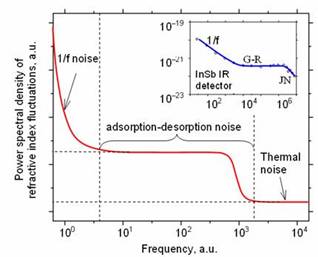The CMT team is one of the leading groups in the world in the field of intrinsic noise mechanisms in microsystems. A special place belongs to investigation of adsorption-desorption noise in resonant structures, including micro/nanocantilever, plasmonic devices, etc. This is a highly complex area: since a typical MEMS system represents a synthesis of miniature mechanical, electronic, optoelectronic and other components, its intrinsic noise will be generated in each of these sub-areas. This means that the total noise of MEMS/NEMS devices will include all types of electronic noises like Johnson-Nyquist (thermal) noise, generation-recombination noise and 1/f (flicker) noise. Mechanical parts contribute to thermomechanical and adsorption-desorption noise. All of these mechanisms impair performances of the microsystem proportionally to noise equivalent power. On the other hand, a majority of these mechanisms are caused by fundamental processes within the device, for instance Johnson-Nyquist noise represents a consequence of the fact that electrons within material are at a temperature above absolute zero. Adsorption-desorption noise will be caused by the same mechanism that ensures the very operation of chemical sensors. In optoelectronic parts of a MEMS system (for instance detectors) the same is valid for the generation-recombination process and generation-recombination noise connected with it. Noise is especially important for miniature cantilevers, membranes, diaphragms and microbridges that represent the mechanical domain of the microsystems.

A similar situation is encountered with plasmonic and generally nanophotonic devices, including plasmonic sensors of chemical or biological analytes. In these devices noise mechanisms occur that are directly connected with the very process of sensing. Besides adsorption-desorption noise, important phenomena include optical equivalents of thermal noise (optical Johnson-Nyquist noise) and of flicker noise, as well as zero-point noise, of special importance for MEMS/NEMS system incorporating nonlinear optical materials.
CMT achieved important results at the world level in the field of theoretical modeling of fluctuation phenomena in micro/nanocantilevers caused by different fundamental mechanisms. Also, CMT researchers originated research of intrinsic noise mechanisms in plasmonic structures, including adsorption-desorption noise in plasmonics.
Besides the results connected with the determination of the influence of adsorption-desorption noise to measured values of refractive index in plasmonic sensors, CMT proposed a figure of merit of plasmonic sensors analogous to specific detectivity in infrared detectors.
